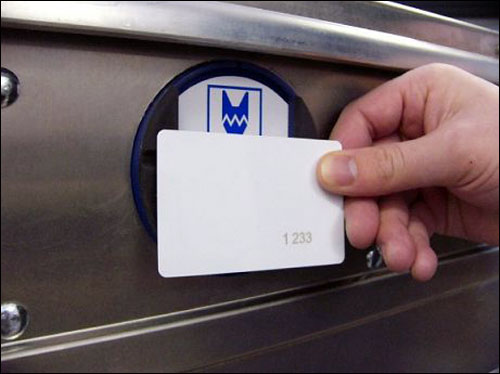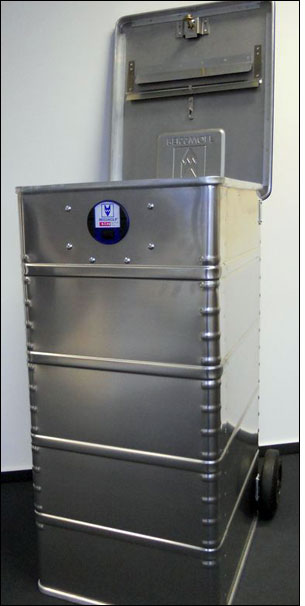Mar 21, 2012Reisswolf, a European document-shredding and confidential-waste-management firm, is employing radio frequency identification in an electronic lock system it calls e.l.sy, to manage its inventory of locking document-disposal containers, as well as to provide security by ensuring that the containers are unlocked only by authorized parties, and at the proper times. With the solution in place, a user not only can manage which individuals can open a particular container, but also view a record indicating when that occurred, and for how long. The company began using the solution for its customers in Switzerland in October 2011, and now offers it in Austria and Germany. Later this month, the firm plans to offer the technology to its customers in Prague, Czech Republic.
The technology underlying the e.l.sy solution is FMTec's security container lock (SECOLO) system, which includes Identec Solutions' SensorSmart software and RFID tag exciters (known as i-Marks), as well as its own RFID-enabled locks and reader access points, to track containers and detect any potential security breaches. To open a container secured by a SECOLO electronic lock, a user employs an RFID chip card or badge instead of a metal key.
For Reisswolf's customers, says Oliver Graumann, the company's CEO, "the key benefits are a general security advantage," as well as the ability to track the locations of its containers, with timestamps of delivery or receipt. The e.l.sy solution also allows its customers to evaluate the use of each container, via historical analysis.
Banks and insurance companies hire firms like Reisswolf to safely dispose of their sensitive paperwork and IT documents. Reisswolf provides locked containers that only authorized personnel can unlock in order to add documents for disposal. The locked containers' contents are then shredded, either at a truck designed for that purpose, located in front of the customer's building—so that the customer can witness the shredding—or at one of Reisswolf's shredding facilities. Typically, there are several different mechanical locks and keys, though the process of managing the locks and keys can be cumbersome, the company reports. Keys can be lost or broken, explains Manfred Falch, FMTec's CEO, and with tens of thousands of containers provided from just one of Reisswolf's sites, it becomes impossible to provide a unique key for every lock.
In a typical scenario, a container is delivered to a user, kept on site for up to a month and is removed to be emptied and its contents destroyed, while a new, empty container is then provided to the customer. In an effort to eliminate confusion involving the keys, Reisswolf had occasionally provided the containers sans keys, so that no users could open them. Sometimes, however, a keyless customer needed to retrieve objects mistakenly placed within a container—for example, if an employee erroneously disposed of a document required by the firm, or dropped a ring or other piece of jewelry through the container's slot. This could lead to considerable inconvenience.
To solve this problem, and to provide secure access only to authorized parties, Reisswolf began using the SECOLO system, which FMTec now also sells to other customers in the secure-document shredding industry, as well as for the secure transporting or storage of pharmaceuticals or health-care materials.
The container's lock also has a reader incorporating a Texas Instruments RFID reader chip that can interrogate HF 13.56 MHz passive tags complying with the ISO 15693 standard.

Here's how the system works: A carrier first delivers the containers, using a handheld RFID reader to document the event. After inputting information regarding the customer's receipt of the containers, the driver then reads the HF tag on each container's lock as it is unloaded, using a Psion Workabout Pro handheld. That individual also provides badges or cards containing passive HF RFID inlays that serve as keys for use by the customer's staff who might require access to the containers. The driver inputs a series of categories by which the individual carrying the badge can be identified—by the company name, building number, floor level or department, for example, or by that person's name. The badge's ID number is also stored in the lock's RFID reader, so that it can determine which badges are authorized to release the lock. In addition, that information is stored in the SECOLO software, once the driver returns to Reisswolf and places the handheld in a docking station. In that way, the company can maintain a record of which containers and badges were delivered to which location, thereby enabling it to use the data for inventory management—tracking which containers are in use, and at which locations.
If a customer's employee needs to open a container, that person must hold his or her badge near the lock and its built-in RFID reader. If the ID number is authorized, the lock releases the locking mechanism. The locking device stores the time at which the lock was opened, as well as the badge's ID number, then stores the time at which the container was closed once more.
Upon retrieving the filled container, the driver can destroy its contents onsite, via a shredder built into the truck, or it can be taken to Reisswolf's secure facility. If the customer opts to destroy its documents onsite, an i-Mark 2 exciter installed on the truck is used to awaken the UHF tag in the container's lock, which then transmits its unique identifier, along with data related to its opening history, to an FMTec AP 750 reader installed in the back of the truck. That data is then forwarded to the handheld Workabout Pro when docked in the truck's cabin. The system utilizes Advanced Encryption Standard (AES) encryption to ensure that the data cannot be collected by an unauthorized reader during transmission. As the container is lifted by the truck's mechanical arm, the AP 750 reader captures the container's ID number, after which the SECOLO software on the Workabout Pro confirms the ID and issues instructions to the lock to release its locking mechanism. At the same time, the reader captures the history of which individuals had accessed the container, as well as when this occurred and for how long.
The SECOLO software, based on Identec's SensorSmart platform, resides on Reisswolf's database and can be integrated with the company's own central management system. The software not only interprets and stores read data, along with each read event's timestamp, but also enables Reisswolf to run reports that help the company analyze the historical use of its containers, and thus improve its own efficiency, based on where those containers are located, as well as when they are and are not in use.
During the second half of 2012, FMTec intends to incorporate GPS and GSM units into the containers it makes, as well as sensors for a variety of environmental conditions, which Reisswolf could use at some locations if so requested by its customers. In this way, the system could send container-opening data in real time, via a cellular connection, in order to report an event, and the GPS location could be transmitted along with the tag's unique ID. In addition, sensors could be utilized for monitoring such conditions as heat, humidity or vibration.
Since the system's installation at its facility in Switzerland and on seven lift trucks, Reisswolf reports, the improved quality of service enabled by offering security for each container without the use of keys—including not only locks with individual access capabilities, but also the ability to track every time that the container is opened, and by whom—has enabled the company to increase its container-rental price by up to 25 percent. What's more, because the system enables improved inventory management, Reisswolf has been able to increase its inventory accuracy by 20 to 30 percent. By the end of this year, the company expects that at least 22 trucks across multiple nations will be equipped with the i-Mark 2 RFID exciters and readers.
"We are currently answering a number of direct inquiries, and have already placed about 500 e.l.sy. containers in different countries of Europe," Graumann states. "There is an ongoing demand concerning this new lock system, and we are very happy to have integrated this innovation into our service portfolio, being the first and exclusive service provider in the document-management sector offering this special feature."



